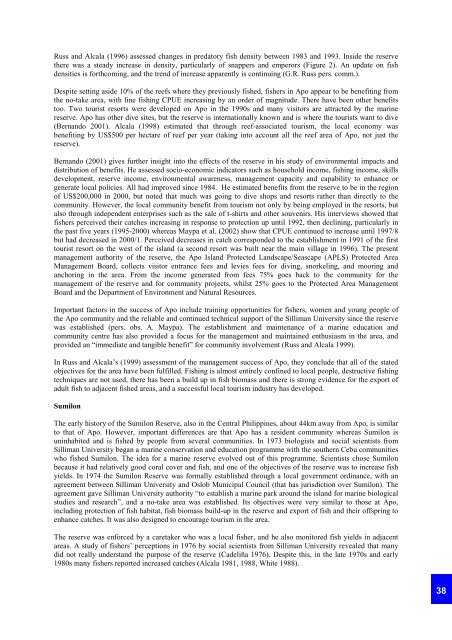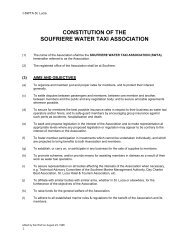WWF Cover photo - Soufriere Marine Management Association ...
WWF Cover photo - Soufriere Marine Management Association ...
WWF Cover photo - Soufriere Marine Management Association ...
Create successful ePaper yourself
Turn your PDF publications into a flip-book with our unique Google optimized e-Paper software.
Russ and Alcala (1996) assessed changes in predatory fish density between 1983 and 1993. Inside the reservethere was a steady increase in density, particularly of snappers and emperors (Figure 2). An update on fishdensities is forthcoming, and the trend of increase apparently is continuing (G.R. Russ pers. comm.).Despite setting aside 10% of the reefs where they previously fished, fishers in Apo appear to be benefiting fromthe no-take area, with line fishing CPUE increasing by an order of magnitude. There have been other benefitstoo. Two tourist resorts were developed on Apo in the 1990s and many visitors are attracted by the marinereserve. Apo has other dive sites, but the reserve is internationally known and is where the tourists want to dive(Bernando 2001). Alcala (1998) estimated that through reef-associated tourism, the local economy wasbenefiting by US$500 per hectare of reef per year (taking into account all the reef area of Apo, not just thereserve).Bernando (2001) gives further insight into the effects of the reserve in his study of environmental impacts anddistribution of benefits. He assessed socio-economic indicators such as household income, fishing income, skillsdevelopment, reserve income, environmental awareness, management capacity and capability to enhance orgenerate local policies. All had improved since 1984. He estimated benefits from the reserve to be in the regionof US$200,000 in 2000, but noted that much was going to dive shops and resorts rather than directly to thecommunity. However, the local community benefit from tourism not only by being employed in the resorts, butalso through independent enterprises such as the sale of t-shirts and other souvenirs. His interviews showed thatfishers perceived their catches increasing in response to protection up until 1992, then declining, particularly inthe past five years (1995-2000) whereas Maypa et al. (2002) show that CPUE continued to increase until 1997/8but had decreased in 2000/1. Perceived decreases in catch corresponded to the establishment in 1991 of the firsttourist resort on the west of the island (a second resort was built near the main village in 1996). The presentmanagement authority of the reserve, the Apo Island Protected Landscape/Seascape (APLS) Protected Area<strong>Management</strong> Board, collects visitor entrance fees and levies fees for diving, snorkeling, and mooring andanchoring in the area. From the income generated from fees 75% goes back to the community for themanagement of the reserve and for community projects, whilst 25% goes to the Protected Area <strong>Management</strong>Board and the Department of Environment and Natural Resources.Important factors in the success of Apo include training opportunities for fishers, women and young people ofthe Apo community and the reliable and continued technical support of the Silliman University since the reservewas established (pers. obs. A. Maypa). The establishment and maintenance of a marine education andcommunity centre has also provided a focus for the management and maintained enthusiasm in the area, andprovided an “immediate and tangible benefit” for community involvement (Russ and Alcala 1999).In Russ and Alcala’s (1999) assessment of the management success of Apo, they conclude that all of the statedobjectives for the area have been fulfilled. Fishing is almost entirely confined to local people, destructive fishingtechniques are not used, there has been a build up in fish biomass and there is strong evidence for the export ofadult fish to adjacent fished areas, and a successful local tourism industry has developed.SumilonThe early history of the Sumilon Reserve, also in the Central Philippines, about 44km away from Apo, is similarto that of Apo. However, important differences are that Apo has a resident community whereas Sumilon isuninhabited and is fished by people from several communities. In 1973 biologists and social scientists fromSilliman University began a marine conservation and education programme with the southern Cebu communitieswho fished Sumilon. The idea for a marine reserve evolved out of this programme. Scientists chose Sumilonbecause it had relatively good coral cover and fish, and one of the objectives of the reserve was to increase fishyields. In 1974 the Sumilon Reserve was formally established through a local government ordinance, with anagreement between Silliman University and Oslob Municipal Council (that has jurisdiction over Sumilon). Theagreement gave Silliman University authority “to establish a marine park around the island for marine biologicalstudies and research”, and a no-take area was established. Its objectives were very similar to those at Apo,including protection of fish habitat, fish biomass build-up in the reserve and export of fish and their offspring toenhance catches. It was also designed to encourage tourism in the area.The reserve was enforced by a caretaker who was a local fisher, and he also monitored fish yields in adjacentareas. A study of fishers’ perceptions in 1976 by social scientists from Silliman University revealed that manydid not really understand the purpose of the reserve (Cadeliña 1976). Despite this, in the late 1970s and early1980s many fishers reported increased catches (Alcala 1981, 1988, White 1988).38



